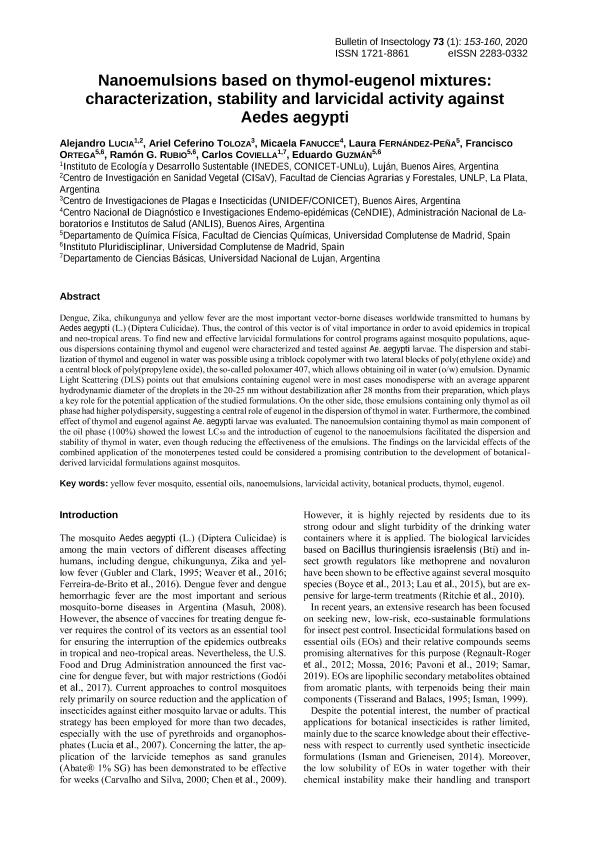Artículo
Nanoemulsions based on thymol-eugenol mixtures: characterization, stability and larvicidal activity against Aedes aegypti
Lucia, Alejandro ; Toloza, Ariel Ceferino
; Toloza, Ariel Ceferino ; Fanucce, Micaela; Fernandez Peña, Laura; Ortega, Francisco; Rubio, Ramón G.; Coviella, Carlos Eduardo; Guzmán, Eduardo
; Fanucce, Micaela; Fernandez Peña, Laura; Ortega, Francisco; Rubio, Ramón G.; Coviella, Carlos Eduardo; Guzmán, Eduardo
 ; Toloza, Ariel Ceferino
; Toloza, Ariel Ceferino ; Fanucce, Micaela; Fernandez Peña, Laura; Ortega, Francisco; Rubio, Ramón G.; Coviella, Carlos Eduardo; Guzmán, Eduardo
; Fanucce, Micaela; Fernandez Peña, Laura; Ortega, Francisco; Rubio, Ramón G.; Coviella, Carlos Eduardo; Guzmán, Eduardo
Fecha de publicación:
04/2020
Editorial:
Alma Mater Studiorum, Univ Bologna
Revista:
Bulletin Of Insectology
ISSN:
1721-8861
Idioma:
Inglés
Tipo de recurso:
Artículo publicado
Clasificación temática:
Resumen
Dengue, Zika, chikungunya and yellow fever are the most important vector-borne diseases worldwide transmitted to humans by Aedes aegypti (L.) (Diptera Culicidae). Thus, the control of this vector is of vital importance in order to avoid epidemics in tropical and neo-tropical areas. To find new and effective larvicidal formulations for control programs against mosquito populations, aqueous dispersions containing thymol and eugenol were characterized and tested against Ae. aegypti larvae. The dispersion and stabilization of thymol and eugenol in water was possible using a triblock copolymer with two lateral blocks of poly(ethylene oxide) and a central block of poly(propylene oxide), the so-called poloxamer 407, which allows obtaining oil in water (o/w) emulsion. Dynamic Light Scattering (DLS) points out that emulsions containing eugenol were in most cases monodisperse with an average apparent hydrodynamic diameter of the droplets in the 20-25 nm without destabilization after 28 months from their preparation, which plays a key role for the potential application of the studied formulations. On the other side, those emulsions containing only thymol as oilphase had higher polydispersity, suggesting a central role of eugenol in the dispersion of thymol in water. Furthermore, the combined effect of thymol and eugenol against Ae. aegypti larvae was evaluated. The nanoemulsion containing thymol as main component of the oil phase (100%) showed the lowest LC50 and the introduction of eugenol to the nanoemulsions facilitated the dispersion andstability of thymol in water, even though reducing the effectiveness of the emulsions. The findings on the larvicidal effects of the combined application of the monoterpenes tested could be considered a promising contribution to the development of botanicalderived larvicidal formulations against mosquitos.
Palabras clave:
THYMOL
,
EUGENOL
,
NANOEMULSIONS
,
AEDES AEGYPTI
Archivos asociados
Licencia
Identificadores
Colecciones
Articulos(INEDES)
Articulos de INSTITUTO DE ECOLOGIA Y DESARROLLO SUSTENTABLE
Articulos de INSTITUTO DE ECOLOGIA Y DESARROLLO SUSTENTABLE
Articulos(UNIDEF)
Articulos de UNIDAD DE INVESTIGACION Y DESARROLLO ESTRATEGICOS PARA LA DEFENSA
Articulos de UNIDAD DE INVESTIGACION Y DESARROLLO ESTRATEGICOS PARA LA DEFENSA
Citación
Lucia, Alejandro; Toloza, Ariel Ceferino; Fanucce, Micaela; Fernandez Peña, Laura; Ortega, Francisco; et al.; Nanoemulsions based on thymol-eugenol mixtures: characterization, stability and larvicidal activity against Aedes aegypti; Alma Mater Studiorum, Univ Bologna; Bulletin Of Insectology; 4-2020; 1-8
Compartir



